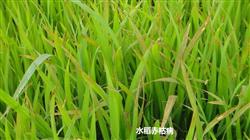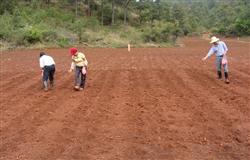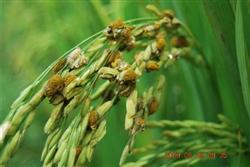Control of Rice Diseases and insect pests: what is Rice Red Blight?

What is rice red blight? What harm does red blight do to rice? How to control rice red blight? Please introduce the harm of rice red blight: Rice red blight, commonly known as bowing seedlings and setting trees, is a physiological disease in rice production. The diseased plants are obviously short, the tillers are small, the angle between the upper leaves and the stem is small, and the young leaves of the diseased plants are dark green or dark green. Most of the diseased plants start from the lower old leaves and gradually expand upward, but the new leaves often remain green. Entering the peak tillering stage, the symptoms are most obvious, the leaves appear clastic brown spots, and then gradually develop into an irregular shape, the growth of diseased plants is slow, and serious fields look like scorched fields, with a general yield reduction of 10-20% and a serious yield reduction of more than 30%. The cause of rice red blight: the lack of soil phosphorus and potassium caused by long-term excessive application of nitrogen fertilizer is the main cause of rice red blight. The imbalance of plant nutrition is caused by the obstruction of root absorption. The roots of rice plants with bacterial blight are affected by organic acids or hydrogen sulfide in the soil, which destroys the normal physiological function. The control methods of rice red blight are as follows: 1. Improve the ventilation of the soil and sun the field at the right time. Combined with the incidence of the disease, 30-50 kg of "black and white ash" (3 parts of plant ash mixed with 1 part of lime) can be applied per mu, or 2.5-4 kg of gypsum or 5-25 kg of lime. For those deficient in phosphorus and potassium, a certain amount of calcium superphosphate and potassium sulfate can be applied. 2. Apply micro-fertilizer. The effect of applying 1 kg of zinc sulfate per mu as base fertilizer is better, and 1 kg of zinc sulfate can also be used as topdressing. The diseased fields can also be foliar sprayed with 5% zinc sulfate fertilizer solution, which can have an immediate effect, but the effect of increasing production is not obvious. Click to get more rice planting techniques click to get more food crop planting techniques
- Prev

How to use herbicide in corn field?
How to use herbicide in corn field? Also ask netizens to help introduce the farming network to sort out the use of herbicides in the corn field and matters needing attention, listed below for your reference. According to the time of application and the principle of weeding, herbicides in corn field are divided into closed herbicides before corn bud and stem and leaf treatment after corn seedlings.
- Next

Prevention and control of rice diseases and insect pests: how to control rice false smut?
How to prevent and cure false smut of rice? What are the hazards of rice false smut? Please introduce the harm of rice false smut: Rice false smut only occurs in the panicle, generally from flowering to milk stage, infected grains, the pathogen grows in the glume, forming rice koji with a diameter of about 1 cm instead of rice grains. ...
Related
- The first cup of black tea in spring, the flavor and history of tea gardens in Kenya, Africa
- The computer can not only choose potatoes, but also grow tea rice. AI will grow winter oolong tea champion.
- It is not only the inflated tea bitten by insects, but also engraved with the four seasons tea in Beipu.
- The Oriental Beauty Tea Festival in Zhuxian County takes the stage at the weekend to experience the plus-size feast of oil tea.
- & quot; Oriental Beauty Tea & Exploration of Emei in Hsinchu, the hometown of quot;
- The new variety of strawberry "Tainong 1" dessert is the first choice with mellow aroma. Crimson gorgeous
- History of Tea in Taiwan: from Wild Inner Mountain to Export Tea Garden
- Two types of Taiwan Oriental Beauty Black Tea won the British three-Star Award for Childhood Tea Xiang Zhang Jiaqi changed from pilot to champion tea maker.
- Banana species and varieties: the planting history of Taiwan Xianren banana and dwarf banana is long, is banana disease resistant?
- Coffee planting Technology: Qianjie Coffee from Seedling to harvesting

